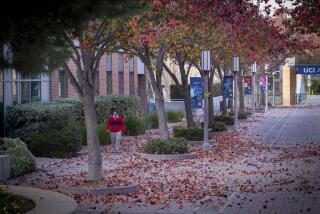California University Costs
* Your editorial, “But Should UCLA Cost as Much as Stanford?” (March 20), accurately points out the conflict between access and rising fees in the University of California and California State University systems. It misses the heart of the problem, however, which is the unwillingness of Californians to pay for education. Open access is possible only when the taxpayers will pay a disproportionate share of the costs; higher fees are necessary when the taxpayers and/or their representatives refuse to pay those costs. Will new taxes be assessed to cover the cost of the expensive and misguided “three strikes and you’re out” bill, so quickly passed and signed without regard to its enormous costs? Recent history suggests that they will not, but prison construction will have to be paid for and so will come from the same pot that funds higher education. The result will be higher fees and even less access.
Another scenario would be to squeeze the universities further and require “more with less,” as the report of the California Higher Education Policy Center suggests, according to the editorial. Our department and most others at CSU Fullerton have been cut close to 30% in the past three years and we are still expected to serve nearly as many students as we did five years ago. For this reason, elective classes in the major, and equipment maintenance and replacement are but memories, while the construction of every course schedule is an exercise in survival. The editorial ignores the fact that we are already doing with much less, and there is precious little room for contraction without the abandonment of programs and/or the watering down of degree requirements to eliminate required classes.
The citizens of this state have a choice to make; pay for access through higher taxation, deny it through higher fees, or dismantle the universities through lack of funding.
GORDON PAINE, Chair
CSU Fullerton Music Department
* Ruth Rosen’s comments in Column Left on March 22 really hit home with me. As a student at UC Irvine for the past two years, I am acutely aware of how much and how fast fees have risen. Last year, annual fees were about $3,100. This was the figure after several consecutive years of increases. This year’s fees went up to almost $4,000 and they are going up again next year. These fees do not include books or room and board, transportation or any other expenses.
And what do we get for this price? With the exception of labs, every single class I’ve had in the past two years has been in an auditorium with 200-400 other students. Yes, there are smaller discussion sections with teaching assistants but this is a poor substitute for being able to carry on a dialogue with a professor as questions arise. There are so many students competing for the professors’ limited office hours that office hours are generally packed with students and resemble discussion sections more than personal assistance.
Rosen is correct in saying that the sacrifices necessary must be shared all around. Over the past five years, the student’s share of the sacrifice has increased dramatically. Perhaps it is time for the upper echelons to join us.
DAVID L. SALAHI
Irvine
* Rosen, a UC Davis professor, bless her, was half-right in attacking UC President Jack Peltason’s largess toward college administrators at taxpayer expense. Alas, half-wrong, she trotted out an educrat’s tired cliches to rationalize her own pay raise. The faculty is “demoralized” and “overburdened.” How so, Ruth, with an average 2.68 classes to teach and graduate assistants to help? Meanwhile, voluntary retirement programs have “devastated” the university, she says. Hardly. A top administrator at UC Irvine says that they can’t get highly paid professors there to retire. With the summer off, and only 2.68 classes to teach, they are already retired, and with a great salary.
JOHN JAEGER
Irvine






